GIS-Based Urban Flood Resilience Assessment Using Urban Flood Resilience Model: A Case Study of Peshawar City, Khyber Pakhtunkhwa, Pakistan
Abstract
1. Introduction
2. Materials and Methods
2.1. The Study Area
2.2. Data Acquisition
3. Urban Flood Resilience Model
4. Generation of Basic Parameters
4.1. Flood Hazard
4.1.1. Elevation
4.1.2. Land Use and Land Cover (LULC)
4.1.3. Curve Number Grid
4.1.4. Slope
4.1.5. Rainfall Grid
4.1.6. Flood Damages
4.2. Exposure
4.2.1. Annual Income
4.2.2. Population Density
4.2.3. Health Facilities
4.2.4. Educational Facilities
4.3. Flood Susceptibility
4.4. Coping Capacity
4.4.1. Economic Capacity
4.4.2. Institutional Capacity
4.4.3. Education Status
5. Analysis of Analytical Hierarchy Process (AHP)
Consistency Ratio
6. Results
6.1. Sensitivity
6.1.1. Hazard (IH)
6.1.2. Exposure (IE)
6.1.3. Susceptibility (IS)
6.2. Coping Capacity (ICc)
7. Urban Flood Resilience
8. Model Validation and Performance Evaluation
9. Comparison of Resilience Level in the Two Zones
10. Discussion
11. Conclusions
Author Contributions
Funding
Acknowledgments
Conflicts of Interest
References
- Bertilsson, L.; Wiklund, K.; de Moura Tebaldi, I.; Rezende, O.M.; Veról, A.P.; Miguez, M.G. Urban flood resilience–A multi-criteria index to integrate flood resilience into urban planning. J. Hydrol. 2019, 573, 970–982. [Google Scholar] [CrossRef]
- Kellens, W.; Terpstra, T.; De Maeyer, P. Perception and communication of flood risks: A systematic review of empirical research. Risk Anal. 2013, 33, 24–49. [Google Scholar] [CrossRef]
- Jha, A.K.; Bloch, R.; Lamond, J. Cities and Flooding: A Guide to Integrated Urban Flood Risk Management for the 21st Century; The World Bank: Washington, DC, USA, 2012; ISBN 9780821388662. [Google Scholar]
- Kastridis, A.; Kirkenidis, C.; Sapountzis, M. An integrated approach of flash flood analysis in ungauged Mediterranean watersheds using post-flood surveys and unmanned aerial vehicles. Hydrol. Process. 2020, 34, 4920–4939. [Google Scholar] [CrossRef]
- Faccini, F.; Luino, F.; Paliaga, G.; Sacchini, A.; Turconi, L.; de Jong, C. Role of rainfall intensity and urban sprawl in the 2014 flash flood in Genoa City, Bisagno catchment (Liguria, Italy). Appl. Geogr. 2018, 98, 224–241. [Google Scholar] [CrossRef]
- Diakakis, M.; Pallikarakis, A.; Katsetsiadou, K. Using a Spatio-Temporal GIS Database to Monitor the Spatial Evolution of Urban Flooding Phenomena. The Case of Athens Metropolitan Area in Greece. ISPRS Int. J. Geo Inf. 2014, 3, 96–109. [Google Scholar] [CrossRef]
- Diakakis, M.; Deligiannakis, G.; Katsetsiadou, K.; Antoniadis, Z.; Melaki, M. Mapping and classification of direct flood impacts in the complex conditions of an urban environment. The case study of the 2014 flood in Athens, Greece. Urban Water J. 2017, 14, 1065–1074. [Google Scholar] [CrossRef]
- Ritchie, H.; Roser, M. Natural Disasters, Empirical View. Our World in Data (2018). Available online: https://ourworldindata.org/natural-disasters (accessed on 7 February 2021).
- Bhatti, A.S.; Wang, G.; Ullah, W.; Ullah, S.; Fiifi Tawia Hagan, D.; Kwesi Nooni, I.; Lou, D.; Ullah, I. Trend in Extreme Precipitation Indices Based on Long Term In Situ Precipitation Records over Pakistan. Water 2020, 12, 797. [Google Scholar] [CrossRef]
- Kreft, S.; Eckstein, D. Global Climate Risk Index Who Suffers Most from Extreme Weather Events? 2020. Available online: https://reliefweb.int/report/world/global-climate-risk-index-2014-who-suffers-most-extreme-weather-events-weather-related (accessed on 7 February 2021).
- Ali, A. Indus Basin Floods: Mechanisms, Impacts, and Management. Available online: http://hdl.handle.net/11540/810 (accessed on 11 March 2020).
- Saqib, S.E.; Ahmad, M.M.; Panezai, S.; Rana, I.A. An empirical assessment of farmers’ risk attitudes in flood-prone areas of Pakistan. Int. J. Disaster Risk Reduct. 2016, 18, 107–114. [Google Scholar] [CrossRef]
- Ullah, F.; Shah, S.A.A.; Saqib, S.E.; Yaseen, M.; Haider, M.S. Households’ flood vulnerability and adaptation: Empirical evidence from mountainous regions of Pakistan. Int. J. Disaster Risk Reduct. 2021, 52, 101967. [Google Scholar] [CrossRef]
- Moghadas, M.; Asadzadeh, A.; Vafeidis, A.; Fekete, A.; Kötter, T. A multi-criteria approach for assessing urban flood resilience in Tehran, Iran. Int. J. Disaster Risk Reduct. 2019. [Google Scholar] [CrossRef]
- Jha Abhas Kand Miner Todd, W.; Stanton-Geddes, Z. Building Urban Resilience: Principles, Tools, and Practice; World Bank Publications: Washington, DC, USA, 2013. [Google Scholar]
- Ahmed, A.K.; White, A. Concepts and practices of ‘resilience’: A compilation from various secondary sources. USA Agency Int. Dev. 2006. [Google Scholar] [CrossRef]
- Birkmann, J.; Wenzel, F.; Greiving, S.; Garschagen, M.; Rilling, B.; Fiedrich, F.; Fekete, A.; Cutter, S.L.; Novák, B.; Wieprecht, S.; et al. Extreme Events, Critical Infrastructures, Human Vulnerability and Strategic Planning: Emerging Research Issues. J. Extrem. Events 2016, 3, 1–25. [Google Scholar] [CrossRef]
- Brand, F.S.; Jax, K.; Brand, F.S.; Jax, K. Focusing the Meaning(s) of Resilience: Resilience as a Descriptive Concept and a Boundary Object. Ecol. Soc. 2007, 12, 23. [Google Scholar] [CrossRef]
- Cutter, S.L. The landscape of disaster resilience indicators in the USA. Nat. Hazards 2016, 80, 741–758. [Google Scholar] [CrossRef]
- Rey, W.; Martínez-Amador, M.; Salles, P.; Mendoza, E.T.; Trejo-Rangel, M.A.; Franklin, G.L.; Ruiz-Salcines, P.; Appendini, C.M.; Quintero-Ibáñez, J. Assessing Different Flood Risk and Damage Approaches: A Case of Study in Progreso, Yucatan, Mexico. J. Mar. Sci. Eng. 2020, 8, 137. [Google Scholar] [CrossRef]
- Silva, D.; Jo, B.M. City Resilience Framework. ARUP 2014, 13, 157–160. [Google Scholar]
- Meerow, S.; Newell, J.P. Urban resilience for whom, what, when, where, and why? Urban Geogr. 2019, 40, 309–329. [Google Scholar] [CrossRef]
- Wright, B. Reducing the complexity of the flood vulnerability index. Environmental Hazards. Environ. Hazards 2010, 9, 321–339. [Google Scholar] [CrossRef]
- Allopn, G.C. Linkages between vulnerability, resilience, and adaptive capacity. Glob. Environ. Chang. 2006, 16, 293–303. [Google Scholar]
- Johannessen, Å.; Wamsler, C. What does resilience mean for urban water services? Ecol. Soc 2017, 22, 1. [Google Scholar] [CrossRef]
- Liao, K.H. A theory on urban resilience to floods-A basis for alternative planning practices. Ecol. Soc. 2012. [Google Scholar] [CrossRef]
- Meerow, S.; Newell, J.P.; Stults, M. Defining urban resilience: A review. Landsc. Urban Plan. 2016, 147, 38–49. [Google Scholar] [CrossRef]
- Shah, A.A.; Ye, J.; Abid, M.; Khan, J.; Amir, S.M. Flood hazards: Household vulnerability and resilience in disaster-prone districts of Khyber Pakhtunkhwa province, Pakistan. Nat. Hazards 2018, 93, 147–165. [Google Scholar] [CrossRef]
- Birkland, T.A.; Waterman, S. The politics and policy challenges of disaster resilience. Resil. Eng. Perspect. 2009, 2, 15–38. [Google Scholar]
- Miguez, M.G.; Veról, A.P. A catchment scale Integrated Flood Resilience Index to support decision making in urban flood control design. Environ. Plan. B Urban Anal. City Sci. 2017, 44, 925–946. [Google Scholar] [CrossRef]
- Kotzee, I.; Reyers, B. Piloting a social-ecological index for measuring flood resilience: A composite index approach. Ecol. Indic. 2016, 60, 45–53. [Google Scholar] [CrossRef]
- Mugume, S.N.; Gomez, D.E.; Fu, G.; Farmani, R.; Butler, D. A global analysis approach for investigating structural resilience in urban drainage systems. Water Res. 2015, 81, 15–26. [Google Scholar] [CrossRef]
- Veról, A.P.; de Oliveira, A.K.B.; Amback, B.C. Aplicação do Índice de Requalificação Fluvial Urbana para Verificação de Intervenções de Controle de Inundações na Bacia dos Rios Pilar-Calombé, RJ. Rev. Nac. Gerenc. Cid. 2020, 8, 17. [Google Scholar] [CrossRef]
- Urban Policy and Planning Unit, K. Urban Policy and Planning Unit–Provincial Land Use Plan (PLUP) Planning and Development Department Government of Khyber Pakhtunkhwa Final Land Use Plan of District Peshawar. Available online: http://urbanpolicyunit.gkp.pk/wp-content/uploads/2020/07/PESHAWAR-LAND-USE-PLAN-final-final-final.pdf (accessed on 9 January 2021).
- PDMA-KP District Disaster Management Plan, Peshawar. Available online: http://kp.gov.pk/uploads/2018/08/DDM_Plan.pdf (accessed on 21 January 2021).
- Cutter, S.L.; Ash, K.D.; Emrich, C.T. The geographies of community disaster resilience. Glob. Environ. Chang. 2014, 29, 65–77. [Google Scholar] [CrossRef]
- Qasim, S.; Qasim, M.; Shrestha, R.P.; Khan, A.N.; Tun, K.; Ashraf, M. Community resilience to flood hazards in Khyber Pukhthunkhwa province of Pakistan. Int. J. Disaster Risk Reduct. 2018, 18, 100–106. [Google Scholar] [CrossRef]
- Ainuddin, S.; Routray, J.K. Earthquake hazards and community resilience in Baluchistan. Nat. Hazards 2012, 63, 909–937. [Google Scholar] [CrossRef]
- Cutter, S.L.; Burton, C.G.; Emrich, C.T. Disaster Resilience Indicators for Benchmarking Baseline Conditions. J. Homel. Secur. Emerg. Manag. 2010, 7. [Google Scholar] [CrossRef]
- Public Health and Engineering Department. Urban Environmental Problems in Pakistan (A Case Study for Urban Environment in Hayatabad, Peshawar); Public Health and Engineering Department: Peshawar, Pakistan, 2012.
- Arshad, M.; Ma, X.; Yin, J.; Ullah, W.; Ali, G.; Ullah, S.; Liu, M.; Shahzaman, M.; Ullah, I. Evaluation of GPM-IMERG and TRMM-3B42 precipitation products over Pakistan. Atmos. Res. 2021, 249, 105341. [Google Scholar] [CrossRef]
- Hoque, M.; Tasfia, S.; Ahmed, N.; Pradhan, B. Assessing Spatial Flood Vulnerability at Kalapara Upazila in Bangladesh Using an Analytic Hierarchy Process. Sensors 2019, 19, 1302. [Google Scholar] [CrossRef] [PubMed]
- Samanta, S.; Koloa, C.; Kumar Pal, D.; Palsamanta, B. Flood Risk Analysis in Lower Part of Markham River Based on Multi-Criteria Decision Approach (MCDA). Hydrology 2016, 3, 29. [Google Scholar] [CrossRef]
- Hadipour, V.; Vafaie, F.; Deilami, K. Coastal Flooding Risk Assessment Using a GIS-Based Spatial Multi-Criteria Decision Analysis Approach. Water 2020, 12, 2379. [Google Scholar] [CrossRef]
- Raziq, A.; Xu, A.; Li, Y. Monitoring of Land Use/Land Cover Changes and Urban Sprawl in Peshawar City in Khyber Pakhtunkhwa: An Application of Geo- Information Techniques Using of Multi-Temporal Satellite Data. J. Remote. Sens. GIS 2016, 5. [Google Scholar] [CrossRef]
- Ullah, K.; Zhang, J. GIS-based flood hazard mapping using relative frequency ratio method: A case study of Panjkora River Basin, eastern Hindu Kush, Pakistan. PLoS ONE 2020, 15, e0229153. [Google Scholar] [CrossRef]
- Shao, Z.; Jahangir, Z.; Muhammad Yasir, Q.; Atta-ur-Rahman; Mahmood, S. Identification of Potential Sites for a Multi-Purpose Dam Using a Dam Suitability Stream Model. Water 2020, 12, 3249. [Google Scholar] [CrossRef]
- Venkatesh Merwade Creating SCS Curve Number Grid using Land Cover and Soil Data. Available online: https://web.ics.purdue.edu/~vmerwade/education/cngrid.pdf (accessed on 27 December 2020).
- National Resources Conservation Service Hydrologic Soil Groups. Part 630 Hydrology National Engineering Handbook; United States Department of Agriculture: Washington, DC, USA, 2007; pp. 1–14.
- Vojtek, M.; Vojteková, J. Flood Susceptibility Mapping on a National Scale in Slovakia Using the Analytical Hierarchy Process. Water 2019, 11, 364. [Google Scholar] [CrossRef]
- Hamidi, A.R.; Wang, J.; Guo, S.; Zeng, Z. Flood vulnerability assessment using MOVE framework: A case study of the northern part of district Peshawar, Pakistan. Nat. Hazards 2020, 101, 385–408. [Google Scholar] [CrossRef]
- Contingency Plan Monsoon Contingency Plan. 2020. Available online: https://www.pdma.gov.pk/sub/uploads/Moonsoon Contigency Plan 2020.pdf (accessed on 3 February 2021).
- Fekete, A. Validation of a social vulnerability index in context to river-floods in Germany. Nat. Hazards Earth Syst. Sci. 2009, 9, 393–403. [Google Scholar] [CrossRef]
- Lemke, P.J.; Ren, R.B.; Alley, I.; Allison, J.; Carrasco, G.; Flato, Y.; Fujii, G.; Kaser, P.; Thomas, R.H.; Zhang, T. Synthesis Report. Contribution of Working Groups I, II & III to the Fourth Assessment Report of the Intergovernmental Panel on Climate Change. Gene. In Climate Change 2007 Mitigation of Climate Change; Cambridge University Press: Cambridge, UK, 2007; Volume 4, pp. 1–861. ISBN 9780511546013. [Google Scholar]
- Ullah, S.; You, Q.; Ullah, W.; Ali, A. Observed changes in precipitation in China-Pakistan economic corridor during 1980–2016. Atmos. Res. 2018, 210, 1–14. [Google Scholar] [CrossRef]
- Ullah, W.; Wang, G.; Ali, G.; Tawia Hagan, D.; Bhatti, A.; Lou, D. Comparing Multiple Precipitation Products against In-Situ Observations over Different Climate Regions of Pakistan. Remote. Sens. 2019, 11, 628. [Google Scholar] [CrossRef]
- Scheuer, S.; Haase, D. Exploring multicriteria flood vulnerability by integrating economic, social and ecological dimensions of flood risk and coping capacity: From a starting point view towards an end point view of vulnerability. Nat. Hazards 2011. [Google Scholar] [CrossRef]
- Hussain, M.; Tayyab, M.; Zhang, J.; Shah, A.A.; Ullah, K.; Mehmood, U.; Al-Shaibah, B. GIS-Based Multi-Criteria Approach for Flood Vulnerability Assessment and Mapping in District Shangla: Khyber Pakhtunkhwa, Pakistan. Sustainability 2021, 13, 3126. [Google Scholar] [CrossRef]
- Bosher, L.; Dainty, A.; Carrillo, P.; Glass, J.; Price, A. Attaining improved resilience to floods: A proactive multi-stakeholder approach. Disaster Prev. Manag. Int. J. 2009, 18, 9–22. [Google Scholar] [CrossRef]
- Zhao, L.; He, F.; Zhao, C. A Framework of Resilience Development for Poor Villages after the Wenchuan Earthquake Based on the Principle of “Build Back Better”. Sustainability 2020, 12, 4979. [Google Scholar] [CrossRef]
- McCarthy, J.J. Climate Change 2001: Impacts, Adaptation, and Vulnerability; Canziani, O.F., Dokken, D.J., White, K.S., Eds.; The Press Syndicate of the University of Cambridge: Cambridge, UK, 2001. [Google Scholar]
- Kienberger, D.S.; Contreras, S.L. Regions of Vulnerability: Spatial Modelling of Different Conceptual Approaches. Available online: http://giscience2010.org/pdfs/paper_241.pdf (accessed on 3 November 2020).
- Nazeer, M.; Bork, H.R. Flood vulnerability assessment through different methodological approaches in the context of North-West Khyber Pakhtunkhwa, Pakistan. Sustainability 2019, 11, 6695. [Google Scholar] [CrossRef]
- Saaty, T.L. Decision making with the analytic hierarchy process. Int. J. Serv. Sci. 2008, 1, 83–98. [Google Scholar] [CrossRef]
- Saaty, T.L. The Analytic Hierarchy Process: Planning, Priority Setting, Resource Allocation; McGraw-Hill International Book Co.: New York, NY, USA; London, UK, 1980. [Google Scholar]
- Pourghasemi, H.R.; Razavi-Termeh, S.V.; Kariminejad, N.; Hong, H.; Chen, W. An assessment of metaheuristic approaches for flood assessment. J. Hydrol. 2020, 582. [Google Scholar] [CrossRef]
- Yesilnacar, E.; Topal, T. Landslide susceptibility mapping: A comparison of logistic regression and neural networks methods in a medium scale study. Eng. Geol. 2005, 79, 251–266. [Google Scholar] [CrossRef]
- Pakistan Economic Survey Pakistan: Flood Impact Assessment. Available online: http://www.finance.gov.pk/survey/chapter_12/highlights.pdf (accessed on 11 February 2021).
- Murayama, Y. Analytic Hierarchy Process in Geospatial Analysis; Murayama, Y., Ed.; Springer: Tokyo, Japan, 2012; ISBN 978-4-431-53999-5. [Google Scholar]
- Saaty, T.L. Group Decision Making and the AHP. In The Analytic Hierarchy Process; Springer: Berlin/Heidelberg, Germany, 1989. [Google Scholar]
- Wannous, C.; Velasquez, G. United Nations Office for Disaster Risk Reduction (UNISDR)—UNISDR’s Contribution to Science and Technology for Disaster Risk Reduction and the Role of the International Consortium on Landslides (ICL). In Advancing Culture of Living with Landslides; Springer International Publishing: Cham, Switzerland, 2017; pp. 109–115. [Google Scholar]
- Rana, I.A.; Routray, J.K. Actual vis-à-vis perceived risk of flood prone urban communities in Pakistan. Int. J. Disaster Risk Reduct. 2016, 19, 366–378. [Google Scholar] [CrossRef]
- Mobini, S.; Becker, P.; Larsson, R.; Berndtsson, R. Systemic Inequity in Urban Flood Exposure and Damage Compensation. Water 2020, 12, 3152. [Google Scholar] [CrossRef]
- Rahman, M.; Chen, N.; Islam, M.; Dewan, A.; Reza, H.; Muhammad, R.; Washakh, A.; Tian, S.; Faiz, H.; Alam, M.; et al. Geoscience Frontiers Location-allocation modeling for emergency evacuation planning with GIS and remote sensing: A case study of Northeast Bangladesh. Geosci. Front. 2021, 12, 101095. [Google Scholar] [CrossRef]
- Rahman, M.; Ningsheng, C.; Iftekhar Mahmud, G.; Monirul Islam, M.; Reza Pourghasemi, H.; Ahmad, H.; Maurice Habumugisha, J.; Muhammad Ali Washakh, R.; Alam, M.; Liu, E.; et al. Flooding and its relationship with land cover change, population growth, and road density. Geosci. Front. 2021, 101224. [Google Scholar] [CrossRef]
- Mynett, A.E.; Vojinovic, Z. Hydroinformatics in multi-colours—Part red: Urban flood and disaster management. J. Hydroinformatics 2009, 11, 166–180. [Google Scholar] [CrossRef]
- Bathrellos, G.D.; Karymbalis, E.; Skilodimou, H.D.; Gaki-Papanastassiou, K.; Baltas, E.A. Urban flood hazard assessment in the basin of Athens Metropolitan city, Greece. Environ. Earth Sci. 2016, 75, 319. [Google Scholar] [CrossRef]
- Rezende, O.M.; Miranda, F.M.; Haddad, A.N.; Miguez, M.G. A framework to evaluate urban flood resilience of design alternatives for flood defence considering future adverse scenarios. Water 2019, 11, 1485. [Google Scholar] [CrossRef]
- Folke, C.; Jansson, Å.; Rockström, J.; Olsson, P.; Carpenter, S.R.; Chapin, F.S.; Crépin, A.-S.; Daily, G.; Danell, K.; Ebbesson, J.; et al. Reconnecting to the biosphere. Ambio 2011, 40, 719–738. [Google Scholar] [CrossRef]
- Andoh, R.Y.; Iwugo, K.O. Sustainable Urban Drainage Systems: A UK Perspective. In Proceedings of the Ninth International Conference on Urban Drainage (9ICUD), Portland, OR, USA, 8–13 September 2002; pp. 1–16. [Google Scholar]
- Brown, R.R.; Keath, N.; Wong, T.H.F. Urban water management in cities: Historical, current and future regimes. Water Sci. Technol. 2009, 59, 847–855. [Google Scholar] [CrossRef] [PubMed]
- Cutter, S.L.; Barnes, L.; Berry, M.; Burton, C.; Evans, E.; Tate, E.; Webb, J. A place-based model for understanding community resilience to natural disasters. Glob. Environ. Chang. 2008, 18, 598–606. [Google Scholar] [CrossRef]





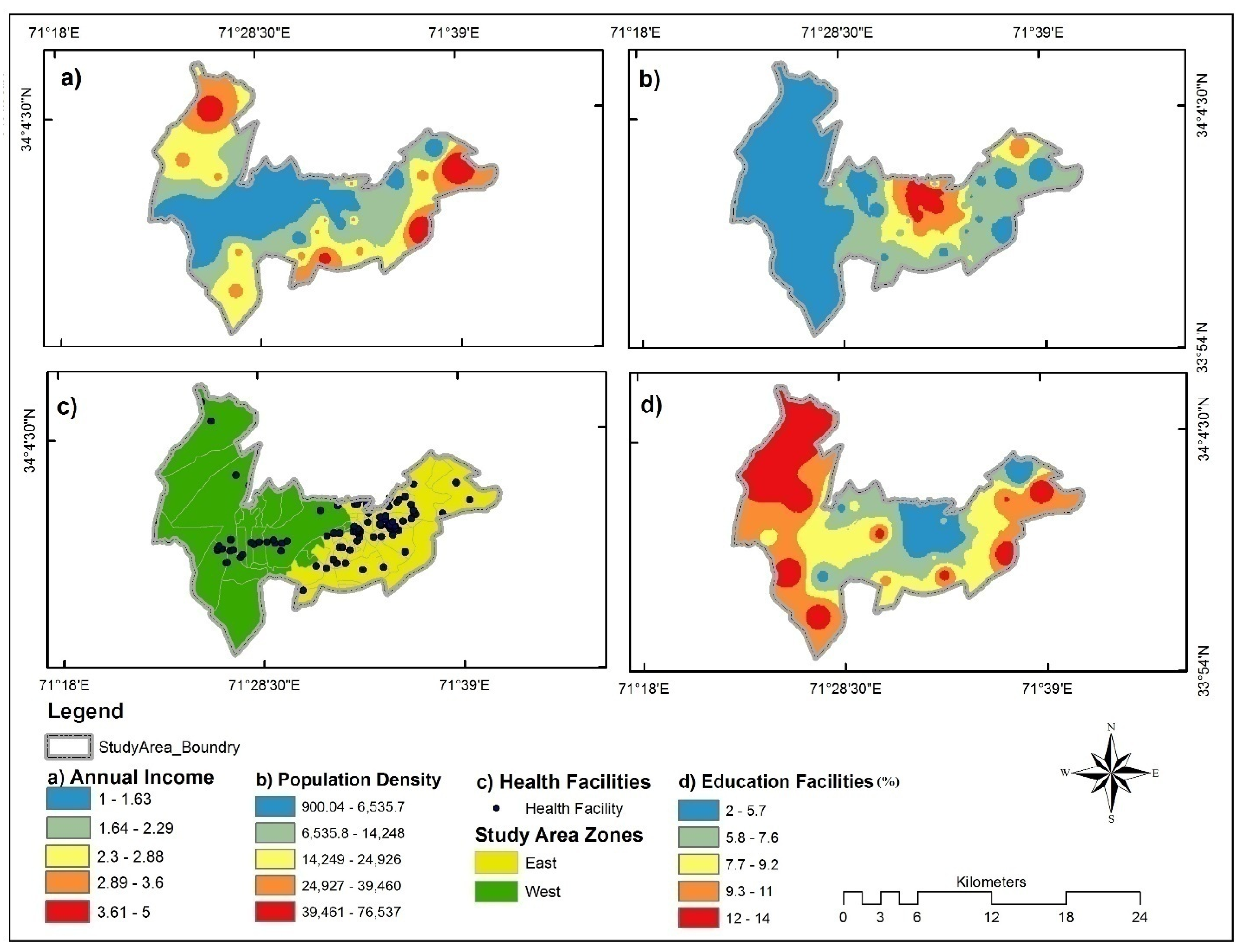

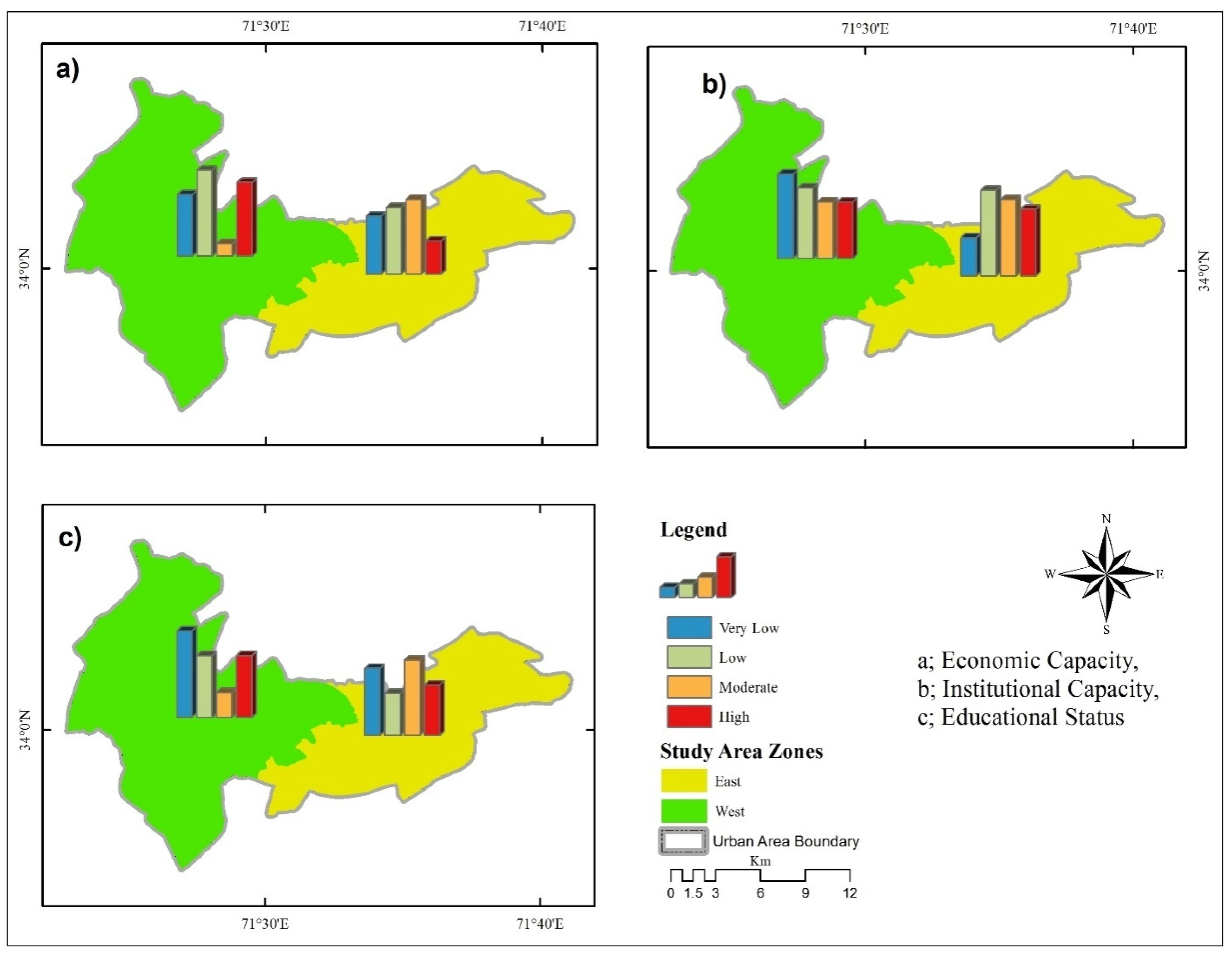
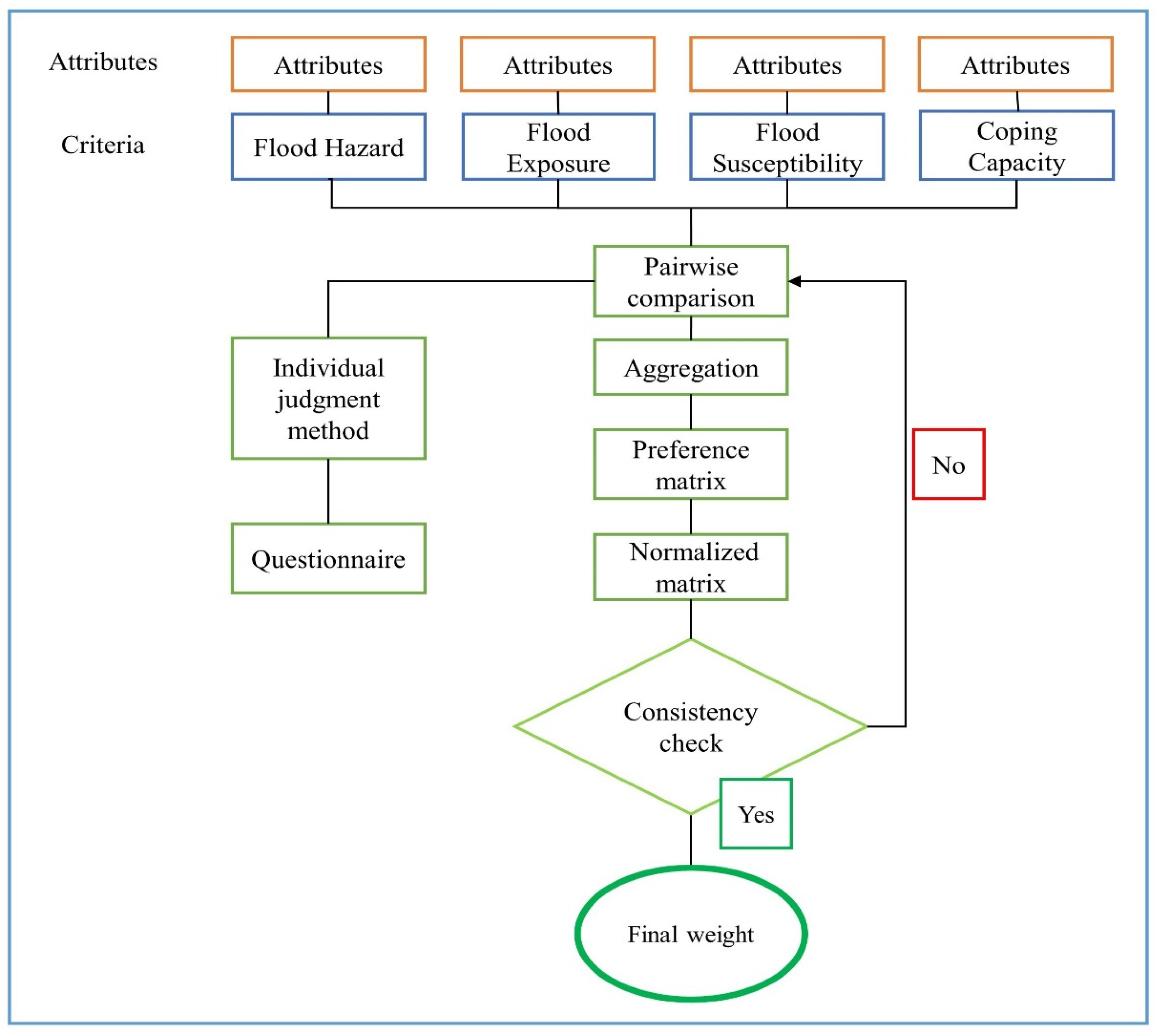
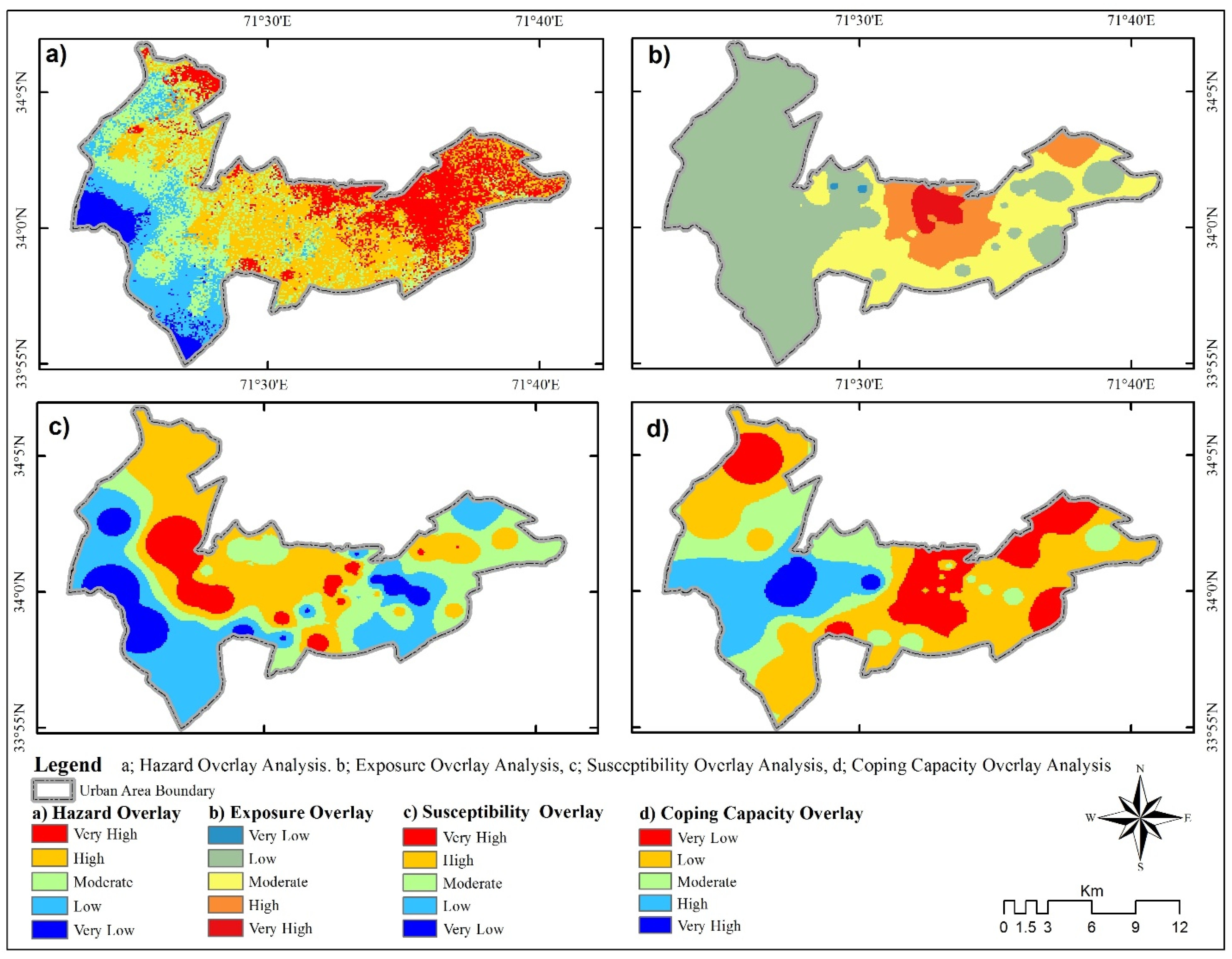

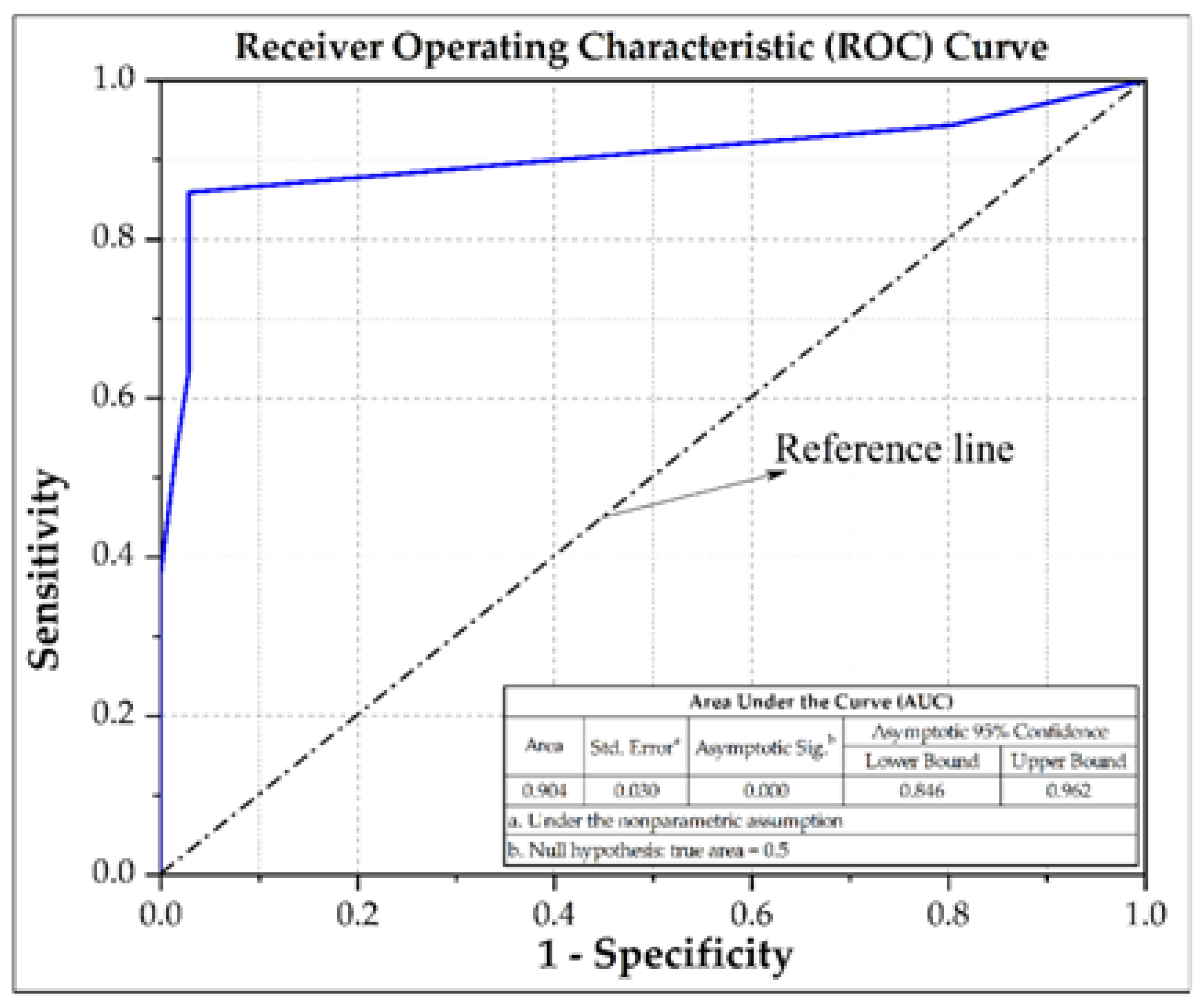
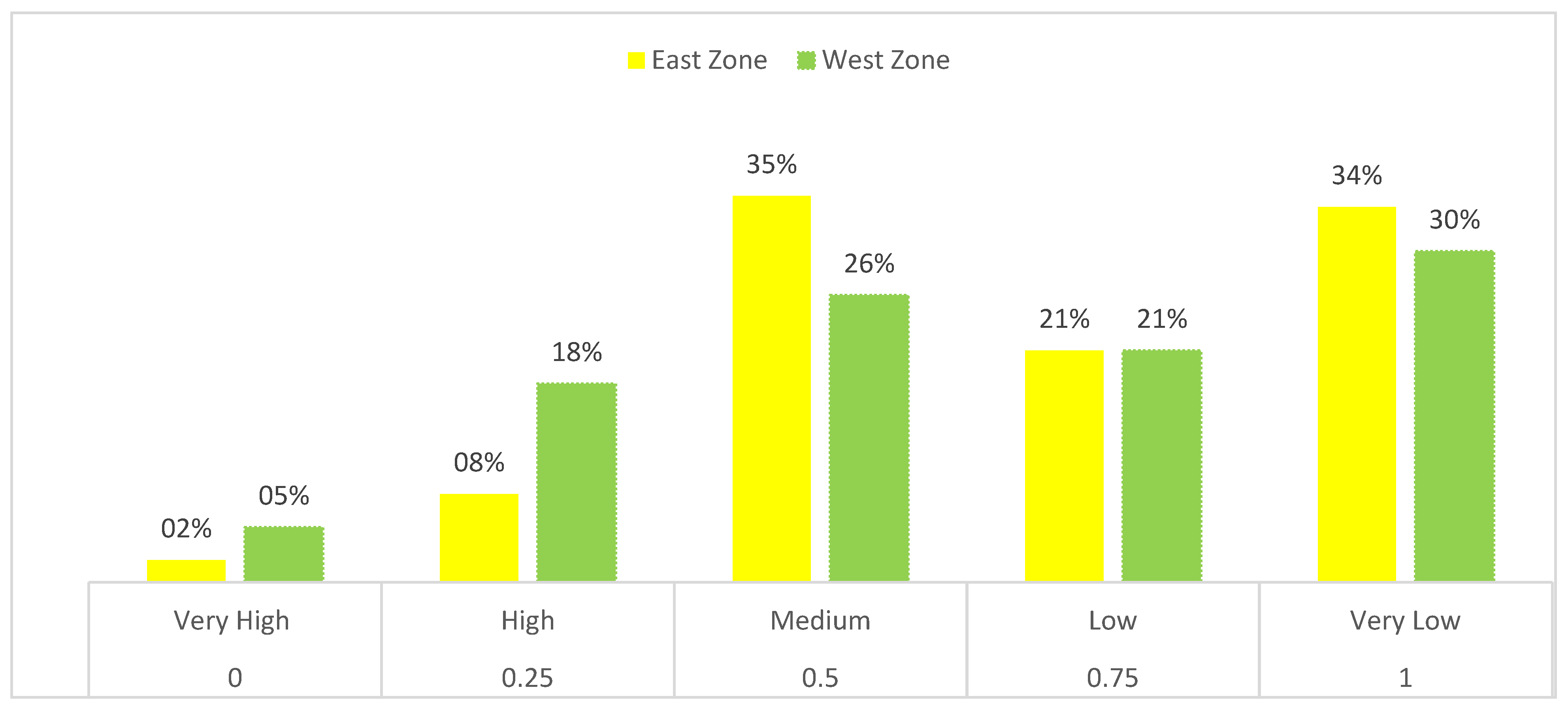
| S.No | Data Type | Source | Period | Mapping Output |
|---|---|---|---|---|
| 1 | Sentinel 2 (10 m) | United States Geological Survey (USGS) https://www.usgs.gov/centers/eros/science/usgs-eros-archive-sentinel-2 (accessed on 2 March 2021) | 2020 | LanduseLandcover (LULC) |
| 2 | ALOS PALSAR (DEM) (12.5 m) | Alaska satellite facility (ASF) https://asf.alaska.edu (accessed on 2 March 2021) | 2020 | Slope, Elevation. |
| 3 | Precipitation | National Aeronautics and Space Administration (NASA); https://power.larc.nasa.gov/data-access-viewer/ (accessed on 2 March 2021) https://giovanni.gsfc.nasa.gov (accessed on 2 March 2021) | 2020 | Precipitation intensity map |
| 4 | Population (Point and statistics) | Pakistan Bureau of Statistics Census | 2017 | Population density map |
| 5 | Soil Data | Soil Conservation Department, Government of Khyber Pakhtunkhwa, Pakistan. | 2016 | Curve Number (CN) grid map (soil type and Hydrological soil groups) |
| 6 | Structured Questionnaire | Field survey | 2–6 November 2020 | Flood damages mapping, Institutional capacity map, Economic capacity map, Education level |
| 7 | Health and Educational facilities (Point and statistics) | Pakistan Bureau of Statistics and Field visits (District Health and Education Departments) | 2017 | Education buildings and Health facilities |
| 8 | Commercial buildings, Residential buildings, and other buildings (Government buildings) | Filed visits to Planning and Development Department, Government of Khyber Pakhtunkhwa, Pakistan | 2020 | Maps for commercial, residential, and other buildings |
| The Intensity of Importance/Judgments | Numeric Value |
|---|---|
| Equal importance | 1 |
| Equal to moderate importance | 2 |
| Moderate importance | 3 |
| Moderate to strong importance | 4 |
| Strong importance | 5 |
| Strong to very strong importance | 6 |
| Very strong importance | 7 |
| Very strong to extremely strong importance | 8 |
| Extreme importance | 9 |
| Hazard (IH) | ||||||
| Criteria | Elevation | LULC | CN Grid | Precipitation | Slop | Flood Damages |
| Elevation | 1 | 2 | 2 | 3 | 2 | 5 |
| LULC | ½ | 1 | 2 | 3 | 3 | 6 |
| CN Grid | ½ | 1/2 | 1 | 5 | 6 | 7 |
| Precipitation | 1/3 | 1/3 | 1/5 | 1 | 2 | 3 |
| Slop | ½ | 1/3 | 1/6 | ½ | 1 | 2 |
| Flood Damages | 1/5 | 1/6 | 1/7 | 1/3 | 1/2 | 1 |
| Total/Sum of all | 3.033 | 4.333 | 5.509 | 12.833 | 14.5 | 24 |
| Exposure (IE) | ||||||
| Criteria | Annual Income | Population Density | Health Facilities | Educational Facilities | ||
| Annual Income | 1 | 3 | 9 | 6 | ||
| Population Density | 1/3 | 1 | 3 | 5 | ||
| Health Facilities | 1/9 | 1/3 | 1 | 2 | ||
| Educational Facilities | 1/6 | 1/5 | ½ | 1 | ||
| Total/Sum of all | 1.611 | 4.533 | 13.5 | 14 | ||
| Susceptibility (IS) | ||||||
| Criteria | Residential Buildings | Commercial Buildings | Other Buildings | |||
| Residential Buildings | 1 | 4 | 7 | |||
| Commercial Buildings | ¼ | 1 | 3 | |||
| Other Buildings | 1/7 | 1/3 | 1 | |||
| Total/Sum of all | 1.393 | 5.33 | 11 | |||
| Coping Capacity (ICc) | ||||||
| Criteria | Institutional Capacity | Institutional Capacity | Institutional Capacity | |||
| Institutional Capacity | 1 | 4 | 6 | |||
| Economic Capacity | ¼ | 1 | 2 | |||
| Education Status | 1/6 | ½ | 1 | |||
| Total/Sum of all | 1.417 | 5.5 | 9 | |||
| Hazard (IH) | ||||||||
| Criteria | Elevation | LULC | CN Grid | Precipitation | Slope | Flood Damages | Average | Weights in % |
| Elevation | 0.330 | 0.461 | 0.363 | 0.234 | 0.138 | 0.208 | 0.29 | 29 |
| LULC | 0.165 | 0.231 | 0.363 | 0.234 | 0.207 | 0.25 | 0.24 | 24 |
| CN Grid | 0.165 | 0.115 | 0.181 | 0.390 | 0.414 | 0.292 | 0.26 | 26 |
| Precipitation | 0.110 | 0.077 | 0.036 | 0.078 | 0.138 | 0.125 | 0.09 | 9 |
| Slop | 0.165 | 0.077 | 0.030 | 0.031 | 0.069 | 0.083 | 0.08 | 8 |
| Flood Damages | 0.066 | 0.038 | 0.026 | 0.026 | 0.034 | 0.042 | 0.04 | 4 |
| Exposure (IE) | ||||||||
| Criteria | Annual Income | Population Density | Health Facilities | Educational Facilities | Weights | Weights in % | ||
| Annual Income | 0.621 | 0.662 | 0.661 | 0.429 | 0.59 | 59 | ||
| Population Density | 0.207 | 0.220 | 0.222 | 0.357 | 0.25 | 25 | ||
| Health Facilities | 0.069 | 0.073 | 0.074 | 0.143 | 0.09 | 9 | ||
| Educational Facilities | 0.103 | 0.044 | 0.037 | 0.071 | 0.06 | 6 | ||
| Susceptibility (IS) | ||||||||
| Criteria | Residential Buildings | Commercial Buildings | Other Buildings | Average | Weights in % | |||
| Residential Buildings | 0.718 | 0.75 | 0.636 | 0.70 | 70 | |||
| Commercial Buildings | 0.179 | 0.187 | 0.273 | 0.21 | 21 | |||
| Other Buildings | 0.103 | 0.063 | 0.091 | 0.09 | 9 | |||
| Coping Capacity (ICc) | ||||||||
| Criteria | Institutional Capacity | Economic Capacity | Education Status | Average | Weights in % | |||
| Institutional Capacity | 0.706 | 0.727 | 0.667 | 0.70 | 70 | |||
| Economic Capacity | 0.176 | 0.182 | 0.222 | 0.19 | 19 | |||
| Education Status | 0.118 | 0.091 | 0.111 | 0.11 | 11 | |||
| Number of Criteria (n) | 2 | 3 | 4 | 5 | 6 | 7 | 8 |
|---|---|---|---|---|---|---|---|
| RI | 0 | 0.52 | 0.9 | 1.12 | 1.24 | 1.32 | 1.41 |
| Hazard (IH) | ||
| Column Wise Sum of Criteria | Criteria Average | Product of Both Columns |
| 3.033 | 0.29 | 0.88 |
| 4.333 | 0.24 | 1.05 |
| 5.519 | 0.26 | 1.43 |
| 12.833 | 0.09 | 1.21 |
| 14.5 | 0.08 | 1.12 |
| 24 | 0.04 | 0.93 |
| λmax = 6.62 | ||
| Exposure (IE) | ||
| Column Wise Sum of Criteria | Criteria Average | Product of Both Columns |
| 1.611 | 0.59 | 0.96 |
| 4.533 | 0.25 | 1.14 |
| 13.5 | 0.09 | 1.21 |
| 14 | 0.06 | 0.90 |
| λmax = 4.21 | ||
| Susceptibility (IS) | ||
| Column Wise Sum of Criteria | Criteria Average | Product of Both Columns |
| 1.393 | 0.70 | 0.98 |
| 5.333 | 0.21 1 | 1.14 |
| 11 | 0.07 | 0.94 |
| λmax = 3.06 | ||
| Coping Capacity (ICc) | ||
| Column Wise Sum of Criteria | Criteria Average | Product of Both Columns |
| 1.417 | 0.70 | 0.99 |
| 5.5 | 0.19 | 1.06 |
| 9 | 0.11 | 0.96 |
| λmax = 3.01 | ||
| Zones | Resilience Level | Preference Value | Area in sq.km | Area % | Directions |
|---|---|---|---|---|---|
| East Zone | Very High | 0 | 02 | 2 | North-west and West-south |
| High | 0.25 | 7.34 | 8 | ||
| Medium | 0.5 | 29.21 | 35 | Central | |
| Low | 0.75 | 18.3 | 21 | ||
| Very Low | 1 | 30 | 34 | North and West | |
| Total | 86.85 | 100 | |||
| West Zone | Very High | 0 | 8.253 | 5 | North-west and Central |
| High | 0.25 | 27 | 18 | ||
| Medium | 0.5 | 39 | 26 | West and East | |
| Low | 0.75 | 31.39 | 21 | ||
| Very Low | 1 | 44.39 | 30 | South and South-west | |
| Total | 150.03 | 100 |
Publisher’s Note: MDPI stays neutral with regard to jurisdictional claims in published maps and institutional affiliations. |
© 2021 by the authors. Licensee MDPI, Basel, Switzerland. This article is an open access article distributed under the terms and conditions of the Creative Commons Attribution (CC BY) license (https://creativecommons.org/licenses/by/4.0/).
Share and Cite
Tayyab, M.; Zhang, J.; Hussain, M.; Ullah, S.; Liu, X.; Khan, S.N.; Baig, M.A.; Hassan, W.; Al-Shaibah, B. GIS-Based Urban Flood Resilience Assessment Using Urban Flood Resilience Model: A Case Study of Peshawar City, Khyber Pakhtunkhwa, Pakistan. Remote Sens. 2021, 13, 1864. https://doi.org/10.3390/rs13101864
Tayyab M, Zhang J, Hussain M, Ullah S, Liu X, Khan SN, Baig MA, Hassan W, Al-Shaibah B. GIS-Based Urban Flood Resilience Assessment Using Urban Flood Resilience Model: A Case Study of Peshawar City, Khyber Pakhtunkhwa, Pakistan. Remote Sensing. 2021; 13(10):1864. https://doi.org/10.3390/rs13101864
Chicago/Turabian StyleTayyab, Muhammad, Jiquan Zhang, Muhammad Hussain, Safi Ullah, Xingpeng Liu, Shah Nawaz Khan, Muhammad Aslam Baig, Waqas Hassan, and Bazel Al-Shaibah. 2021. "GIS-Based Urban Flood Resilience Assessment Using Urban Flood Resilience Model: A Case Study of Peshawar City, Khyber Pakhtunkhwa, Pakistan" Remote Sensing 13, no. 10: 1864. https://doi.org/10.3390/rs13101864
APA StyleTayyab, M., Zhang, J., Hussain, M., Ullah, S., Liu, X., Khan, S. N., Baig, M. A., Hassan, W., & Al-Shaibah, B. (2021). GIS-Based Urban Flood Resilience Assessment Using Urban Flood Resilience Model: A Case Study of Peshawar City, Khyber Pakhtunkhwa, Pakistan. Remote Sensing, 13(10), 1864. https://doi.org/10.3390/rs13101864













